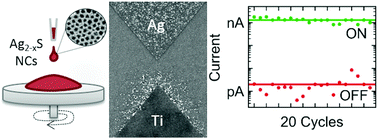Solution-processed silver sulphide nanocrystal film for resistive switching memories†
Abstract
Resistive switching memories allow electrical control of the conductivity of a material, by inducing a high resistance (OFF) or a low resistance (ON) state, using electrochemical and ion transport processes. As an alternative to high temperature and vacuum-based physical sulphurization methods of silver (Ag), here we propose, as a resistive switching medium, a layer built from colloidal Ag2−xS nanocrystals – compatible with solution-processed approaches. The effects of the electrode size (from macro- to micro-scale), composition (Ag, Ti and Pt) and geometry on the device performance together with the electrochemical mechanisms involved are evaluated. We achieved an optimized Ag/Ti bowtie proof-of-concept configuration by e-beam lithography, which fulfils the general requirements for ReRAM devices in terms of low power consumption and a reliable ION/IOFF ratio. This configuration demonstrates reproducible switching between ON and OFF states with data endurance of at least 20 cycles; and an ION/IOFF ratio up to 103 at low power consumption (0.1 V read-out), which outperforms previous results in the literature for devices with resistive layers fabricated from silver chalcogenide nanoparticles.



 Please wait while we load your content...
Please wait while we load your content...